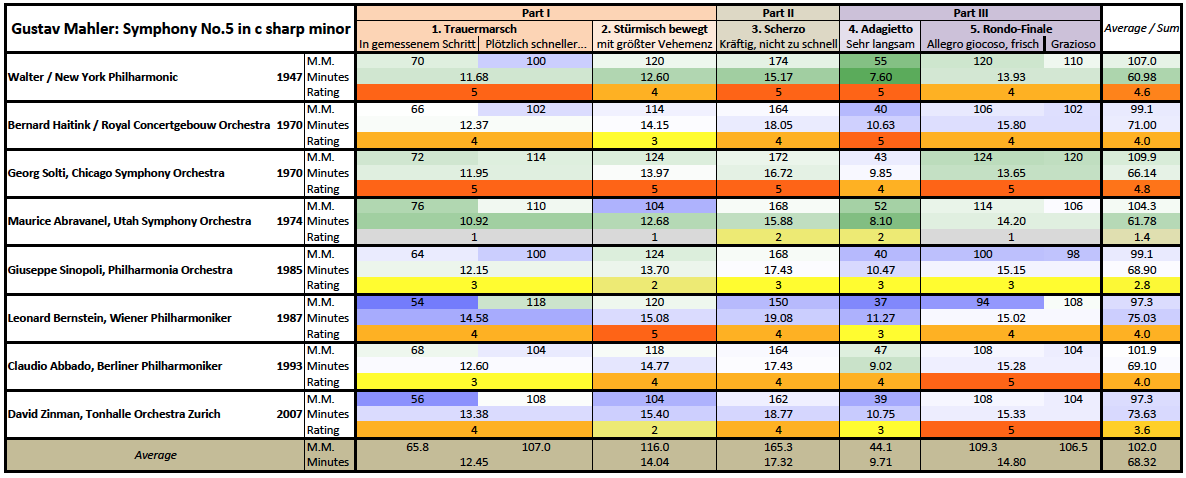Gustav Mahler
Symphony No.5 in C♯ minor
Media Review / Comparison
2015-01-17 — Original posting
2015-07-04 — Added link for music score
2016-08-01 — Brushed up for better readability
Table of Contents
- Introduction / The Recordings
- Background, About the Composition
- The Movements
- The Interpretations, Overview
- The Interpretations, Detail
- Bruno Walter , New York Philharmonic Orchestra (1947)
- Bernard Haitink , Royal Concertgebouw Orchestra (1970)
- Georg Solti , Chicago Symphony Orchestra (1970)
- Maurice Abravanel , Utah Symphony Orchestra (1974)
- Giuseppe Sinopoli , Philharmonia Orchestra (1985)
- Leonard Bernstein , Wiener Philharmoniker (1987)
- Claudio Abbado , Berliner Philharmoniker (1993)
- David Zinman , Tonhalle Orchestra Zurich (2007)
- Addendum
Introduction / The Recordings
This posting is about Gustav Mahler‘s Symphony No.5 in C♯ minor, of which I currently have 8 recordings, sorted by the conductor’s last name:
- Claudio Abbado, Berliner Philharmoniker (1993)
- Maurice Abravanel, Utah Symphony Orchestra (1974)
- Leonard Bernstein, Wiener Philharmoniker (1987)
- Bernard Haitink, Royal Concertgebouw Orchestra (1970)
- Giuseppe Sinopoli, Philharmonia Orchestra (1985)
- Georg Solti, Chicago Symphony Orchestra (1970)
- Bruno Walter, New York Philharmonic Orchestra (1947)
- David Zinman, Tonhalle Orchestra Zurich (2007)
In the sections below, the recordings are discussed in chronological order (by the year of the recording).
Walter, Haitink, Solti, Abravanel, and Bernstein were also present in my LP collection, the Sinopoli CD is from my parent’s collection, the others were added in order to include interpretations from recent decades for comparison.
Background, About the Composition
Gustav Mahler (1860 – 1911) wrote his Symphony No.5 in C♯ minor around 1901 – 1903; it was premiered in Cologne in 1904, played by the Gürzenich Orchestra under the direction of the composer. After four symphonies either with movements with vocal participation (2, 3, 4) or with strong ties to vocal music (1), Symphony No.5 is more of a “classical” symphony, at least in that it is “non-vocal”; it has five, not four movements, though, which Mahler grouped in three parts; certainly, the first two movements (Part I) can be seen as components of a single movement, which would then lead to a “standard” scheme, i.e., first movement/part — Scherzo — Adagietto — Rondo-Finale. The symphony uses a fairly big orchestra, featuring
- flutes: 4 (2 alternating with piccolos)
- oboes: 3 (1 alternating with cor anglais)
- clarinets: 3 (1 alternating with bass clarinet)
- bassoons: 3 (1 alternating with contrabassoon)
- horns: 6
- trumpets: 4
- trombones: 3
- bass tuba
- a rich set of percussion (4 timpani, big drums, triangle, tamtam, etc.)
- harp,
- strings
The Movements
As mentioned, this symphony has five movements; I’m not going to attempt an analysis, but I’m merely giving an outline if the movements, based on Mahler’s annotations. My score (Edition Eulenburg, No. 532) has bar numbers at the beginning of each page, plus Mahler’s section numbering, here indicated with [1], [2], etc. (starting at [1] in each movement); I’m first giving the annotations in German (or Italian), as found in the score, then I’m giving my free translations as well. I have omitted small-scale rubato instructions, e.g., Pesante for 1 bar only, followed by a Tempo I.
As the text below shows, Mahler is extremely detailed and specific about the agogics / rubato. However, he does not specify metronome rates, so the closest source for the “authentic, absolute tempo” are interpretations by conductors such as Bruno Walter, who still knew the composer personally, well and closely. Beyond what is shown below, Mahler also gives extremely detailed instructions on articulation and playing modes (e.g., which part of the bow to use, where the bow should touch the string, whether wind instruments need to hold up the cone towards the audience, etc.), as well as specific instructions for the conductor. The list below would be endless with all this!
Part I — I. Trauermarsch (415 bars, 2/2)
Annotations
In gemessenem Schritt. Streng. Wie ein Kondukt (in measured pace, strict, like a funeral procession) —
[1] — Pesante (heavy) —
[2] Etwas gehaltener (holding back a bit) —
[3] Wie zu Anfang (as in the beginning) — Nicht schleppen (don’t drag) —
[4] Wieder etwas gehaltener (holding back a bit again) — [5] — [6] —
[7] Plötzlich schneller. Leidenschaftlich. Wild (suddenly faster, passionate, wildly) — [8] — [9] —
[10] — Allmählich sich beruhigend (gradually calming down) —
[11] — Unmerklich zu Tempo I zurückgehen (indiscernibly return to Tempo I) — Tempo I —
[12] Schwer (heavy) — [13] — [14] —
[15] Immer dasselbe Tempo (always the same tempo) — [16] — [17] —
[18] Klagend (lamenting) — Zurückhaltend (holding back) — Poco meno mosso — Streng im Tempo (holding tempo strictly) — Nicht zurückhalten (don’t hold back) —
[19] Schwer
Comments
One note about the tempo in this movement: some conductors appear to think of music played at a typical State funeral when interpreting “Wie ein Kondukt”. However, this rather refers to funeral marches as played in Vienna / Austria at the end of the 19th century, and this is substantially faster, as seen in Bruno Walter‘s interpretation.
And here’s a detail about Mahler’s annotation fine print: on the first page, referring to the trumpet voices, the score notes “Die Auftakt-Triolen dieses Themas müssen stets etwas flüchtig (quasi accel.) nach Art der Militärfanfaren vorgetragen werden“, i.e., “the upbeat triplets of this theme must always be played somewhat superficially (quasi accelerando), in the manner of military fanfares”. Not all conductors observe (or dare observing) this. The middle part is very emotional, but to me the most intense moment in this movement is at [19], with this slow, descending, stepping, comforting farewell melody, into which the trumpet signal (from the beginning) twice inexorably reminds us that this is a final goodbye…
II. Stürmisch bewegt, mit größter Vehemenz (576 bars, 2/2)
Annotations
Stürmisch bewegt, mit größter Vehemenz (moving impetuously, with utter vehemence) — a tempo — [1] … [4] — Drängend (urging) — Sehr drängend (strongly urging) —
[5] Bedeutend langsamer (im Tempo des ersten Satzes “Trauermarsch”) (much slower, in the tempo if the first movement, “funeral march”) — [6] … [8] — Etwas zurückhaltend —
[9] Tempo I subito — Streng im Takt (strictly holding pace) — [10] —
[11] Drängend (urging) — Langsam, aber immer 2/2 (slower, but always 2/2) —
[13] — Von hier an nicht mehr schleppen! (don’t drag from here onward) —
[14] — unmerklich belebend (reviving indiscernibly) — Immer noch drängend (still urging) —
[15] Plötzlich wieder bedeutend langsamer, im Tempo des ersten Satzes “Trauermarsch” (suddenly again much slower, in the tempo if the first movement, “funeral march”) —
[16] — Più mosso subito, aber immer noch nicht so schnell wie zu Anfang (Più mosso subito, but still not as fast as the beginning)
[17] Unmerklich drängend (urging indiscernibly) — [18] Tempo I subito —[19] — [20] — Etwas langsamer, ohne zu schleppen (somewhat slower, without dragging) — [21] —
[22] — Nicht schleppen (don’t drag) —
[23] Nicht eilen (don’t rush) — Gehalten (holding) —
[24] Etwas drängend (urging somewhat) — Nicht eilen! (don’t rush!) — Wuchtig (massive) —
[25] Etwas drängend —
[26] Unmerklich drängend (urging indiscernibly) — [27] Pesante, plötzlich etwas anhaltend (heavy, suddenly holding up a bit) — Allmählich fließender (gradually more flowing) —
[28] Nicht schleppen, Tempo I — Vorwärts, unmerklich (indiscernibly forward) — accelerando — a tempo —
[29] — Ritenuto —
[30] Tempo I subito, etwas langsamer als zu Anfang (somewhat slower than at the beginning) — Nicht eilen (don’t rush) — Pesante —
[31] Nicht eilen — [32] — Nicht eilen — Allmählich (aber unmerklich) etwas ruhiger (gradually — but indiscernibly — somewhat calmer)
[33] a tempo (molto moderato) — Ritardando — Langsam (slow) — Folgt lange Pause (a long pause follows).
Comments
Mahler designated this as a component of “Part I” — indeed, that movement includes reminiscences from the funeral march in the first movement, though not direct quotes.
Part II — III. Scherzo (819 bars, 3/4)
Annotations
Kräftig, nicht zu schnell (vigorously, not too fast) — [1] … [3] —
[4] — Nicht eilen (don’t rush) —
[5] Wieder fliessend (flowing again) —
[6] Etwas ruhiger (somewhat calmer) —
[7] Tempo I —
[8] — Allmählich ruhiger (gradually calmer) — Langsamer (slower)
[9] Wieder allmählich belebend (gradually reviving again) — Drängend (urging) —
[10] Etwas zurückhaltend (holding back somewhat) — Tempo, poco sostenuto — quasi a tempo I — … —
[11] Molto moderato — Fliessender, aber immer gemässigt (more fluent, but always moderate) — [12] —
[13] Nicht eilen —
[14] — a Tempo molto moderato — allmählich bewegter, ins Tempo I übergehend (gradually more moving, transitioning to Tempo I) —
[15] Tempo I — Nicht schleppen (don’t drag) —
[20] — Unmerklich drängend (urging indiscernibly) —
[21] Nicht schleppen — Drängend — [22] —
[23] Nicht ritenuto — Das Tempo unmerklich etwas einhaltend (slightly holding back indiscernibly) —
[24] Wieder zum Tempo I zurückkehrend (returning to Tempo I again) — Kräftig, Tempo I (vigorously) —
[25] Vorwärts drängend (urging forward) — [26] — [27] —
[28] Tempo I subito — nicht rit. — rit. — a tempo, schnell (fast) — langsam (slow) — a tempo —
[29] a tempo — rit. — a tempo — rit. — molto rit. — a tempo moderato — rit. —
[30] a tempo, mässig (moderate) — Tempo I subito — Più mosso — Sehr wild (very wildly) — Drängend (urging) —
[31] — Noch rascher (even faster) —
[32] — Sehr drängend bis zum Schluss (very urging, up to the end)
Comments
Judging from Bruno Walter‘s interpretation: to me, a grotesque parody of a carnival scene, ranging from boisterous to hilarious, to surreal — brilliant, for sure!
Part III — IV. Adagietto (103 bars, 4/4)
Annotations
Sehr langsam (very slow) — Nicht schleppen, etwas flüssiger als zu Anfang (don’t drag, somewhat more fluent than at the beginning) —
[1] — Wieder äusserst langsam (extremely slow again) — etwas drängend (urging slightly) — Fliessend (fluent) — zurückhaltend (holding back) —
[2] Fliessender (more fluent)— Etwas drängend — Fliessend (fluent) — zurückhaltend (holding back) —
[3] — Tempo I (Molto Adagio) —
[4] Zögernd, rit. (hesitating, rit.) — Noch langsamer (even slower) — Drängend (urging)
Comments
A very well — maybe too well — known movement (not just from Luchino Visconti’s film “Death in Venice”), maybe played too often; the only saving grace is that it is often played so slowly that people in our time probably don’t have the time and the patience to listen through it. The movement is said to be a love song for Alma whom, he met and married around the time of the composition. Strangely enough, I find that this movement is closely related to No.3 of Mahler’s Rückert Lieder, “Ich bin der Welt abhanden gekommen” (I am lost to the world): not exactly a love song, from the text — rather a final farewell! But the two pieces use the same melodic and harmonic language.
V. Rondo-Finale (791 bars, 2/2)
Annotations
Allegro — Etwas langsamer (somewhat slower) — riten. — Allegro giocoso. Frisch (freshly) — [1] —
[2] sempre l’istesso Tempo —
[3] — Grazioso — [4] —
[5] a tempo I subito — [6] — sempre l’istesso Tempo —
[7] Nicht eilen (don’t rush) — Grazioso — [8] — a Tempo — [9] Fliessend (flowing) — [10] —
[11] — sempre l’istesso Tempo — [12] —
[13] — Nicht eilen (don’t rush) — [14] —
[15] — Grazioso — [16] — Nicht eilen — [17] — Nicht eilen — [18] … [20] —
[22] Nicht eilen —Nicht eilen — [23] … [25] —
[26] — Unmerklich etwas einhaltend (slightly holding back indiscernibly) —
[27] — Grazioso — [28] … [30] —
[31] Allmählich und stetig drängend (gradually and persistently urging) — [32] —
[33] Sehr drängend (very urging) — Pesante —
[34] Allegro molto und bis zum Schluss beschleunigend (accelerating up to the end) — Presto
Comments
What a change from the Adagietto! A really joyful movement (giocoso, after all!), with polyphony, virtuosic, almost baroque-style fugato passages, even a stretto, interspersed with chorale-like, homophonic sections. One can sense that enthusiasm, even ecstasy carried through this composition!
The Interpretations, Overview
In order to provide a rating overview, as well as an idea about tempo relations both within an interpretation, as well as between the two recordings, I have prepared the table below. The color coding for the tempo (blue = slower, green = faster) refers to the average between the recordings; metronome rates were measured in the first segment with a given, main tempo annotation (as given in the table) only:
Note that the metronome rates for the Adagietto are rough estimates only, calculated as average from the overall duration of the piece. For the other movements, the metronome ratings and durations don’t always appear to go together — that’s because I focused on measuring the early metronome rates in main tempo segments only: with so many tempo changes (let alone rubato, etc.) in every movement, tracking these changes with metronome rates is hopeless. The ratings are meant to be relative only and my subjective judgement. The durations in the table are without applause (Abbado).
The Interpretations, Detail
The recordings are listed and discussed below in chronological order (see above). However, this is not the order in which I listened through the music. Also, Mahler’s music is extremely multi-faceted. Trying to discuss every aspect of every movement in every interpretation would fill a book; I’m focusing on key points that struck me as relevant / worth noting; the comments are not meant to be comprehensive / detailed explanations / justifications for the ratings in the above table.
Bruno Walter, New York Philharmonic Orchestra (1947)
Mahler: Symphonies No. 4 & 5, “Lieder und Gesänge aus der Jugendzeit”
Bruno Walter, New York Philharmonic Orchestra
Sony Classic 515301 2 (2 CDs, mono); ℗ / © 2004
Booklet: 10 pp., English

Bruno Walter (1876 – 1962) knew and was friends with the composer. His recordings (this one from 1947, hence a mono recording) are a unique opportunity for us to listen to an authentic record of how Mahler wanted to have his symphonies played. Maybe not in every detail, but certainly in many, basic aspects. I had this recording with the New York Philharmonic Orchestra as double LP set (together with symphony No.4), and I’m happy that it was re-issued on CD.
Notes on the Movements
Part I — I. Trauermarsch(2/2)
Duration: 11’41”
Sure, the sound in this recording can’t compete with newer stereo CDs. However, what a revelation this CD is! First of course, the tempo: Bruno Walter knows what the proper tempo for a funeral march (in the late 19th century in Vienna / Austria) is — faster than many appear to think! I particularly like the relentlessness of the march after [5].
Walter not only offers an accurate and authentic reading of the score in dynamics, articulation and tempo, he actually opens a whole new dimension in intra-bar agogics / rubato, where sometimes every beat in a bar gets its own weight. Something that appears to have been forgotten with modern conductors! Walter avoids excesses in the tempo and provides a very good representation of Mahler’s dynamics; the upbeat triplets in the beginning (and later on, of course) are following Mahler’s prescription, though not as explicitly, obvious and maybe exaggerated as with Zinman. To me, the only “hair in the soup” is with the tuning of the timpani, which appears to degrade over the course of the movement.
II. Stürmisch bewegt, mit größter Vehemenz (2/2)
Duration: 12’36”
Excellent again, of course, showing Mahler’s tempo relations, the appropriate amount of rubato, etc. — and it also shows that the slower parts are not a serene summer scene out in nature, but a piece with tension, a sometimes painful reminiscence of the funeral scene in the first movement, and the fast part is not festive or exuberant, but dramatic, full of tension! But on the other hand, more than the first movement, this shows the limitations of a mono recording: music with such complexity suffers when it is squeezed though a tiny hole!
Part II — III. Scherzo (3/4)
Duration: 15’10”
Excellent: the authoritative interpretation, truly authentic. Yes, the recording technique imposes restrictions on the sound and the dynamic range. Nevertheless, the recording still captures the atmosphere of the movement, the parody, the grotesqueness; the tempo is never heavy, and the last part a surreal, drunken ride in total delirium!
Part III — IV. Adagietto (4/4)
Duration: 7’36”
Ah — another revelation: intensity and warmth, even intimacy don’t depend on the tempo! This is the fastest performance of this movement. Yet, nothing is rushed, Walter leaves time for individual phrases, he does not stick to a strict metrum; to me, this is on a par with Haitink‘s totally different (& slower) version. Yes, there is enough vibrato (Zeitgeist!), but at this tempo it doesn’t really hurt; also, the tempo makes it much easier to avoid excess sweetness
V. Rondo-Finale (2/2)
Duration: 13’56”
Bruno Walter is again providing an authentic reading of this movement — in one of the fastest interpretations. Unfortunately, the orchestra is reaching its limitations here. There are frequent coordination issues in the fugato sections. But apart from that, the interpretation is enthralling and keeps its drive through the end.
Overall Duration: 60’57”
Rating (see above for details): 4.6 — An amazing interpretation and recording, given that it is soon 70 years old, and a must-have even just for its authenticity!
Bernard Haitink, Royal Concertgebouw Orchestra (1970)
Mahler: The Symphonies
Bernard Haitink, Royal Concertgebouw Orchestra
Philips 442 050-2 (10 CDs, stereo); ℗ 1962 – 1994 / © 1994
Booklet: 60 pp., en/de/fr

Bernard Haitink (1929 – 2021) is a prominent conductor of Mahler’s music, and with the Royal Concertgebouw Orchestra Amsterdam he was building on a long legacy and tradition of Mahler performances, started by Willem Mengelberg (1871 – 1951). Haitink’s interpretations (in two LP boxes) were my first recordings of Mahler’s symphonies.
Notes on the Movements
Part I — I. Trauermarsch(2/2)
Duration: 12’22”
The initial upbeat triplets are too metric, but the tempo of the funeral march is good (better than with Bernstein or Zinman, for sure!), the dynamics better than with Abbado (though could still be more explicit), the orchestra better than the Philharmonia under Sinopoli. At [2], the annotation is “Etwas gehaltener” (holding back somewhat) — that is barely noticeable.
II. Stürmisch bewegt, mit größter Vehemenz (2/2)
Duration: 14’09”
More direct, “concrete” than Abbado, keeps suspense & drive (where appropriate) throughout the movement.
Part II — III. Scherzo (3/4)
Duration: 18’03”
Avoiding extremes, but full of swing (a paraphrase of a Viennese waltz!) in the “dance portions”, well-played. The slow portions tend to be a rather slow, but always retain tension. The wild parts could be more exuberant.
Part III — IV. Adagietto (4/4)
Duration: 10’38”
Very slow, but not static, nor too metric (rubato!), not using an excess of vibrato: deeply moving, excellent!
V. Rondo-Finale (2/2)
Duration: 15’48”
A good interpretation, with better acoustic balance (basses) than Leonard Bernstein‘s recording, excellent orchestra, overall (string sound, brass).
Overall Duration: 71’00”
Rating (see above for details): 4.0 — A good, solid interpretation at the very least. And I’m really touched by Haitink’s Adagietto!
Georg Solti, Chicago Symphony Orchestra (1970)
Mahler: The Symphonies
Georg Solti, Chicago Symphony Orchestra
London 430 804-2 (CD, stereo); ℗ 1970 – 1984 / © 1991
Booklet: 66 pp., English

Sir Georg Solti (1912 – 1997) realized his recording of all Mahler symphonies with the Chicago Symphony Orchestra between 1970 and 1983: No.5 and No.6 were recorded in 1970, No.7 and No.8 in 1971, all other symphonies were recorded between 1980 and 1983, spanning a major part of the 22 years during which he was music director with that orchestra. This symphony therefore is among the oldest in the series. Even though the quality of the orchestra was rather modest when Solti started directing it, this symphony provides an excellent record of Solti’s qualities as a conductor.
Notes on the Movements
Part I — I. Trauermarsch(2/2)
Duration: 11’57”
An excellent recording, combining a fidelity to the score similar to Bruno Walter‘s with an emotionality similar to Bernstein‘s — certainly often as eruptive as the latter! And from his Austro-Hungarian provenance he knew what the appropriate tempo for a funeral march is! The stereo setup is a bit limited, not always balanced, but to me, that’s a minor issue.
II. Stürmisch bewegt, mit größter Vehemenz (2/2)
Duration: 13’58”
Eruptive, truly wild, emote, storming forward in the fast parts — excellent playing for an orchestra that described itself as provincial when Solti joined it! In the slow parts, the music is full of tension, suspense, expectations: very good, overall!
Part II — III. Scherzo (3/4)
Duration: 16’43”
Simply excellent! Wild, enthralling, never too slow, keeps rhythmic tension, suspense — to me, clearly the best Scherzo in this comparison!
Part III — IV. Adagietto (4/4)
Duration: 9’51”
Not too slow / good tempo, very intense & emotional — does not quite match Haitink‘s intimacy and warmth, though, but still one of the best in this movement.
V. Rondo-Finale (2/2)
Duration: 13’39”
The fastest interpretation of this movement, and by far the one with the most “pull”, the enthralling drive, emotional build-up to the overwhelming culmination & climax at the end. the orchestra may not be as polished as others, but its performance is absolutely impressive. To me, this beats everybody else!
Overall Duration: 66’06”
Rating (see above for details): 4.8 — My favorite recording overall, no doubt — even though for the Adagietto I prefer Haitink.
Maurice Abravanel, Utah Symphony Orchestra (1974)
Mahler: Symphonies No. 5 & 6
Maurice Abravanel, Utah Symphony Orchestra
Vanguard Classics ATM-CD-1220 (2 CDs, stereo); ℗ / © 2003
Booklet: 6 pp., English

Maurice Abravanel’s complete recording of all Mahler symphonies was the second one in my LP collection, after the boxes with Haitink’s interpretation. Maurice Abravanel(1903 – 1993) is somewhat of an outsider in this comparison (or in the Mahler discography) — it took an almost heroic effort to make this recording happen (he recorded all Mahler symphonies with the Utah Symphony Orchestra, between 1963 and 1974) and the orchestra to survive a financial crisis. The symphony No.5 was recorded in 1974. I initially liked this recording, even preferred it over Haitink’s set — probably because with my stereo equipment (loudspeakers) that recording appeared to have more spatial width (& depth?) than Haitink’s recording; my views have changed since then!
Notes on the Movements
Part I — I. Trauermarsch(2/2)
Duration: 10’55”
Abravanel starts with a good tempo — the fastest in this comparison, actually, and he remains on the fast side throughout the movement. As for the interpretation: 8 bars after [3], the “Nicht schleppen” (Don’t drag) in my opinion means one should not let the pace slow down or drag — here, it is erroneously interpreted as instruction to switch to a faster tempo, which doesn’t make sense. Section [12], “Schwer” (heavy), is somewhat slower, but not really heavy in character, and at [15] “Immer dasselbe Tempo” (always the same tempo) I feel exactly the opposite — a sudden change in tempo at that point.
The main flaw with this recording is that the orchestra is clearly playing at its limits, fighting coordination issues and rhythmic inaccuracies (e.g., some punctuated notes are “softened” almost to triplets). To me, also the tuning (timpani, e.g.) is sometimes marginal (Mahler must have been extremely meticulous about tuning — why otherwise would he write “tune well!” over the final note for the timpani in the second movement?).
II. Stürmisch bewegt, mit größter Vehemenz (2/2)
Duration: 12’41”
Lacking rhythmic precision / coordination, coherence, and the acoustic balance is often fairly oddly off (not every instrument must be audible as if it was in the center of the podium!).
Part II — III. Scherzo (3/4)
Duration: 15’53”
A (nicely played) harmless children’s comedy rather than the grotesque parody intended by Mahler, hardly ever more than ff, far too tamed.
Part III — IV. Adagietto (4/4)
Duration: 8’06”
Almost as fast as Bruno Walter, but badly coordinated, voices don’t act as one ensemble, even individual voices are not homogeneous (problems with Abravanel’s rubato?), too much vibrato — sorry, out of luck!
V. Rondo-Finale (2/2)
Duration: 14’12”
The interpretation starts rather fast (almost as fast as Bruno Walter) — but the orchestra is obviously challenged: not only does it run into coordination problems, but there are occasional intonation issues, some string passages in the polyphonic parts are played superficially, not always articulated properly, plus, the orchestra (or the conductor) appears to have problems with tempo control, as they are sometimes accelerating in fugato passages where they are challenged already!
Overall Duration: 61’45”
Rating (see above for details): 1.4 — The effort is honorable — unfortunately, the result can’t really compete here!
Giuseppe Sinopoli, Philharmonia Orchestra (1985)
Mahler: Symphony No. 5
Giuseppe Sinopoli, Philharmonia Orchestra
DG 415 476-2 (CD, stereo); ℗ / © 1985
Booklet: 16 pp., de/en/fr

I wasn’t even aware of the fact that Giuseppe Sinopoli (1946 – 2001) had recorded Mahler symphonies, but found this CD in my parent’s collection. Sinopoli was principal conductor of the Philharmonia Orchestra between 1984 and 1994, and during that time he recorded all Mahler symphonies. The symphony No.5 was recorded in 1985, i.e., early in his cooperation with that orchestra.
Notes on the Movements
Part I — I. Trauermarsch(2/2)
Duration: 12’09”
To me, this is a recording with compact sound, not very prominent & differentiated string sound (the violins sometimes with fairly strong vibrato, the brass sometimes dominating), rhythmically better than Abravanel, somewhat soft in character, lacking transparency, emotional warmth, and dynamic differentiation (also dynamic differentiation within the orchestra). But overall, it is a sound interpretation.
II. Stürmisch bewegt, mit größter Vehemenz (2/2)
Duration: 13’42”
Eruptive in the beginning, fast — but with superficialities in the articulation, occasional lack in clarity, slight coordination issues, extra noises from the conductor? Probably too many microphones, too close — an impression which appears confirmed by the occasional, sudden appearance of a brass instrument in the very center / foreground. The slower parts sound / feel too loud, compared to other interpretations, the movement lacks contrasts / dynamic span.
Part II — III. Scherzo (3/4)
Duration: 17’26”
Sometimes heavy, close to clumsy; at [6] the annotation is “Etwas ruhiger” (somewhat calmer) — here, the slow-down is too extreme; often too slow in the slower parts, losing the Scherzo character (the boisterous sections are typically OK). Why do I need to hear the conductor singing along?
Part III — IV. Adagietto (4/4)
Duration: 10’28”
Slow, somewhat structureless, occasional intonation issues due to excess vibrato in the violins.
V. Rondo-Finale (2/2)
Duration: 15’09”
A reasonable start, although the tempo is slightly on the slow side (for Allegro or Giocoso); after [6], at Sempre l’istesso tempo the tempo is actually faster and accelerates; 10 bars later, at [7], Mahler writes “Nicht eilen” (don’t hurry) — the music keeps accelerating. An excess vibrato is affecting the intonation. Overall, not always quite following the score, particularly in the tempo.
Overall Duration: 68’53”
Rating (see above for details): 2.8 — Not the worst recording, but also not my favorite, for sure.
Leonard Bernstein, Wiener Philharmoniker (1987)
Mahler II — Symphonies No. 5 – 7, Rückert Lieder, Kindertotenlieder
Leonard Bernstein, Wiener Philharmoniker
New York Philharmonic (Symphony No.7)
DG 477 518-1 (5 CDs, stereo); ℗ 1986 – 1991 / © 2005
Booklet: 22 pp., en/de/fr

Leonard Bernstein (1918 – 1990) has recorded the Mahler symphonies twice. The first recording was made in the 1960’s, with the New York Philharmonic Orchestra.
Bernstein then tackled all symphonies again, this time involving several orchestras: the symphonies No.7 (1985), No.2 and No.3 (1987) were again done with the New York Philharmonics, the symphonies No.9 (1985), No. 1 and No.4 (1987) were recorded with the Royal Concertgebouw Orkest Amsterdam, the symphonies No.5 (1987) and No.6 (1988) were recorded with the Vienna Philharmonic Orchestra, and finally, the symphonies No.8 (1975) and No.10 (1974) were taken from earlier recordings, again with the Vienna Philharmonic Orchestra. Bernstein was a very compassionate Mahler conductor — he lived that music with all his exuberant emotionality, maybe sometimes going a bit overboard…
Notes on the Movements
Part I — I. Trauermarsch(2/2)
Duration: 14’35”
A very emotional, expressive and direct performance — the strongest moment for me being the sad descent at [19] (“Schwer“). Maybe the vibrato in the violins is sometimes on the strong side (whenever the score calls for espressivo), and the upbeat triplets at the very beginning are rather metric. The main (though not crucial) flaw to me is that the tempo in the first part is clearly too slow — not really a march at all, but that probably corresponds to how Bernstein felt about this music?
II. Stürmisch bewegt, mit größter Vehemenz (2/2)
Duration: 15’05”
Excellent: eruptive, very emotional!
Part II — III. Scherzo (3/4)
Duration: 19’05”
Tends towards slow, heavy tempo, but rhythmically very explicit, rubato!
Part III — IV. Adagietto (4/4)
Duration: 11’16”
Extremely slow, way too much vibrato, and why extra portamento?? Some of the quavers appear too metric: some rubato in lieu of vibrato and portamento would have been better.
V. Rondo-Finale (2/2)
Duration: 15’02”
The “Allegro giocoso. Frisch” is definitely not Allegro, let alone giocoso or fresh. Bernstein is rather liberal in the interpretation of tempo annotations — more than once, Sempre l’istesso tempo not only starts faster, but then continues accelerating — he is apparently getting carried away by the music — and the build-up throughout the movement is impressive. The orchestra (tone, articulation, coordination, etc.) is excellent throughout — the basses are sometimes a bit too massive (that may be the technician or the conductor, though), and the interpretation is sometimes close to overblown.
Overall Duration: 75’03”
Rating (see above for details): 4.0 — An excellent interpretation in many aspects — some of it may sound a bit overblown / exaggerated.
Claudio Abbado, Berliner Philharmoniker (1993)
Mahler: The 10 Symphonies
Claudio Abbado, Berliner Philharmoniker (1, 5, 8)
Wiener Philharmoniker (2, 3, 4, 9, 10), Chicago Symphony Orchestra (6, 7)
DG 447 023-2 (12 CDs, stereo); ℗ 1978 – 1995 / © 2000
Booklet: 98 pp., en/de/fr

To Claudio Abbado (1933 – 2014), Gustav Mahler was one of the favorite composers. Over the years of his career, he frequently played his symphonies; the above set is his first complete recording, produced with various orchestras between 1977 and 1994. Symphony No.5 was recorded live in 1993, with the Berlin Philharmonic Orchestra. From 1999 onwards, Abbado started re-recording the Mahler symphonies, initially with the Berlin Philharmonic Orchestra: No.3 in 1999, No.7 in 2001, No.9 in 2002, No.6 in 2004 (live recording), No.4 in 2005), more recent recordings exist from concerts with the Lucerne Festival Orchestra, with the Gustav Mahler Youth Orchestra, and more.
Claudio Abbado was well-known for being able to create a special atmosphere in his concerts, full of subtleties, as well as suspense — in his own words, a successful concert meant that the audience remained silent for a long time at the end, before starting to applaude (and he must have achieved that almost regularly in his late years). One can see this happen in Abbado’s late video recordings — unfortunately, it often (regularly?) doesn’t appear to transpire through audio-only / CD recordings.
Notes on the Movements
Part I — I. Trauermarsch(2/2)
Duration: 12’36”
Much clearer in sound than Sinopoli, excellent string sound; overall, a subtle interpretation, though (to me) a bit too tamed, avoiding extremes — e.g., the Pesante at [9] could be more explicit, and the upbeat triplets at the very beginning are too metric. On the other hand, I like the melancholic, expressive mood at [15] (Immer dasselbe Tempo) and the section that follow, up to the end: the strongest moments in this interpretation!
II. Stürmisch bewegt, mit größter Vehemenz (2/2)
Duration: 14’46”
Emotional, good, better than the first movement, excellent playing! I’m not sure whether the extra portamenti in the violins are a good idea: Mahler is very specific where he wants a portamento and marks those instances in the score.
Part II — III. Scherzo (3/4)
Duration: 17’26”
Very well played, but too respectful — could be more aggressive, more of a parody. Slow sections tend to be rather too slow. But the final section is really good, wild!
Part III — IV. Adagietto (4/4)
Duration: 9’01”
Good tempo, good agogics, emotional, intense; unfortunately at the border of being overblown in articulation (portamenti) and tone (vibrato, at least not a heavy one).
V. Rondo-Finale (2/2)
Duration: 15’17”, without the applause, 15’40” with applause
An excellent interpretation — to me, Abbado’s best movement in this symphony. The tempo starts moderate, but the orchestra sound (throughout), articulation and rhythmic discipline / coordination are excellent; Abbado carefully observes the score, and I like those minute hold-ups after the last beat, when he wants to highlight an accent in the following bar! An enthralling interpretation — and an ending that did not lead to a silence in the audience, of course!
Overall Duration: 69’28”
Rating (see above for details): 4.0 — Not quite the same as a live Abbado concert experience, but still a very good interpretation!
David Zinman, Tonhalle Orchestra Zurich (2007)
Mahler: Symphony No. 5
David Zinman, Tonhalle Orchestra Zurich
Sony BMG CD 88697 31450 2 (SACD / DSD / CD, multichannel stereo); ℗ / © 2008
Booklet: 32 pp., de/en/fr

Between 2006 and 2010, David Zinman (*1936) recorded all of Mahler’s symphonies with the Tonhalle Orchestra Zurich — probably the coronation of Zinman’s cooperation with this orchestra, which lasted almost 20 years, from 1995 till 2014. This symphony was recorded in 2007.
Notes on the Movements
Part I — I. Trauermarsch (2/2)
Duration: 13’23”
Among all recordings in this comparison, this one clearly provides the most accurate and detailed reading of the score, in articulation, dynamics, and all of Mahler’s small-print. One obvious example: the initial upbeat triplets in the trumpet to me sounded superficial, a little too fast — then I checked the score, and sure enough, that’s exactly what Mahler wanted, and no other interpretation made this perceptible! The orchestra is very transparent, precise, clear in its articulation — Zinman has led the orchestra to previously (in this ensemble) unprecedented levels of precision and virtuosity.
My only points of criticism are with the tempo: as with Bernstein, the funeral march is definitely too slow and does not resemble a marching pace at all. Also, after [3], the “Nicht schleppen” (don’t drag) is taken as indication for a faster tempo, which I don’t think is correct.
II. Stürmisch bewegt, mit größter Vehemenz (2/2)
Duration: 15’24”
As accurate and detailed in reading the score as in the first movement, again with excellent sound and near-perfect playing by the orchestra; unfortunately, after [3], the interpretation appears to lose drive, and the slow parts (e.g., from [5] on) sounds harmless, like a summer afternoon in nature, with birds singing and butterflies dancing — that can’t have been Mahler’s idea in a movement that refers back to the first one, with its funeral march. Also: at [17], the “Unmerklich drängend” (urging indiscernibly) is clearly more than indiscernibly accelerating. I’m not convinced about this interpretation.
Part II — III. Scherzo (3/4)
Duration: 18’46”
Well-played (near-perfect, indeed), but too well-behaved. Appears to hesitate, possibly afraid of going overboard, and as with others, the “Etwas ruhiger” ([6]) is more than that: much slower.
Part III — IV. Adagietto (4/4)
Duration: 10’45”
Too slow, too sweet, static, too much vibrato.
V. Rondo-Finale (2/2)
Duration: 15’20”
Essentially see the first movement: excellent orchestral discipline (coordination, tone, articulation), and again a most accurate and detail reading of the score; the orchestra is in excellent shape, and even section such as [21]f., or [28]f., which often sound chaotic even with good or famous orchestras — here, they suddenly make sense, are rhythmically clear and transparent. If I’m giving a top rating here, it’s primarily for the achievement of the orchestra — ideally, I’d like to have a little more of Bernstein‘s, Abbado‘s or Solti‘s emotionality / exuberance.
Overall Duration: 73’36”
Rating (see above for details): 3.6 — I particularly like the (local) orchestra’s excellent achievement here, and the excellent, accurate & detailed score reading, though I don’t always agree with Zinman’s interpretation.
Addendum
For the Mahler’s Symphony No.5 I have used the Eulenburg pocket score —Find pocket score on amazon.com—



















